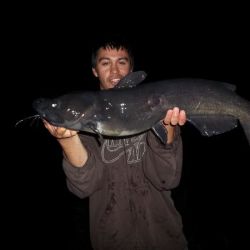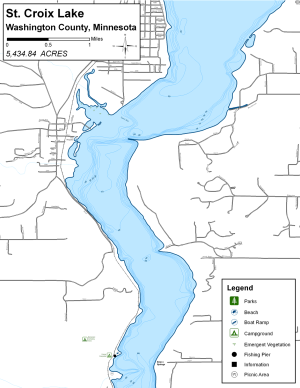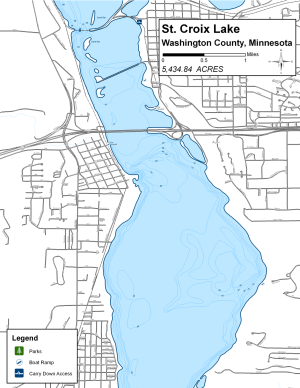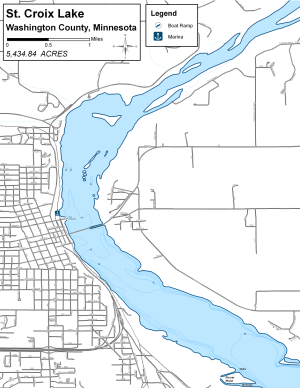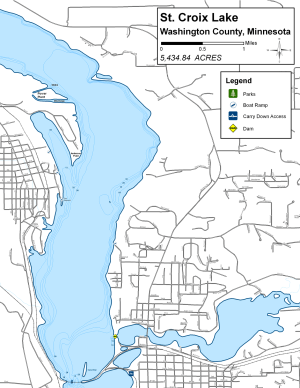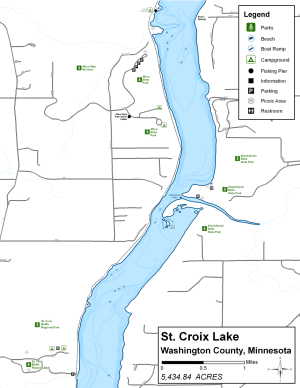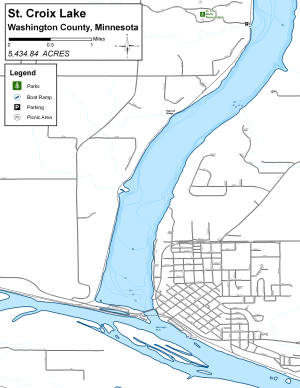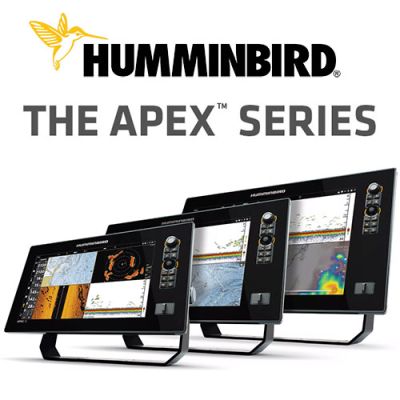Today's Best Fishing Times
Get the best fishing times for Lake St. Croix with Lake-Link's Fishing Forecast. SEE MORE
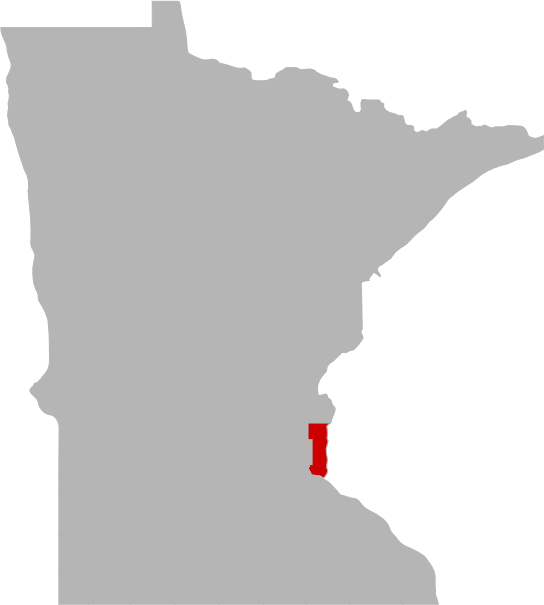
St. Croix Lake is known for its excellent fishing opportunities and is home to a variety of fish species, including walleye, northern pike, bass, and panfish, which are popular targets for anglers. The lake is also popular for boating, swimming, and other water-based activities. The lake has a maximum depth of 78 feet, which makes it ideal for swimming and other water sports.
The lake is surrounded by several parks and campgrounds, making it a popular destination for outdoor enthusiasts. Visitors can enjoy hiking and biking trails, picnic areas, and other recreational activities in the area.
St. Croix Lake is located near the St. Croix River, which is a designated National Scenic Riverway and offers a variety of recreational opportunities, including canoeing, kayaking, and fishing. The river also provides a scenic backdrop for the lake and is a popular destination for tourists and locals alike
Overall, St. Croix Lake is a popular and vibrant natural resource in eastern Minnesota, offering a wide range of recreational opportunities and ecological significance. The lake is also known for its picturesque beauty and peaceful atmosphere, making it a popular destination for those seeking a quiet retreat in nature.

Share Your Catch & Win!
Frequently Asked Questions About Lake St. Croix , MN
- How big is Lake St. Croix ?
- How deep is Lake St. Croix ?
- What kind of fish can you catch in Lake St. Croix ?
- Are there places to stay in the Lake St. Croix area?
- Are there topographical lake maps available Lake St. Croix ?
- Are there places to eat and drink near Lake St. Croix ?
- What is the average air temp for Lake St. Croix ?
- Are there any state parks near Lake St. Croix ?
How big is Lake St. Croix ?
How deep is Lake St. Croix ?
What kind of fish can you catch in Lake St. Croix ?
Other fish species in the lake include American Eel, Blue Sucker, Bluntnose Minnow, Emerald Shiner, Fathead Minnow, Freshwater Drum, Gizzard Shad, Golden Redhorse, Green Sunfish, Highfin Carpsucker, Hybrid Sunfish, Johnny Darter, Logperch, Northern Hog Sucker, Quillback, River Carpsucker, River Redhorse, Shorthead Redhorse, Silver Lamprey, Silver Redhorse, Smallmouth Buffalo, Spottail Shiner, Spotted Sucker, Western Sand Darter and White Sucker.
Are there places to stay in the Lake St. Croix area?
More Lodging Options
Are there topographical lake maps available Lake St. Croix ?
Are there places to eat and drink near Lake St. Croix ?
What aquatic invasive species are found in Lake St. Croix ?
Join us in the fight to prevent the spread of invasive species These sneaky creatures can hitch a ride on boats, clinging onto propellers, anchor lines, and trailers. They can even survive in hidden places like bilge water and ballast tanks, or disguise themselves in dirt and sand that sticks to nets, buckets, anchors, and waders. But don't worry, we have the power to stop them in their tracks with just a few simple steps. So let's do our part and protect our waters from these unwanted invaders.
History & Status of the Fishery
Our goal in the 2014 survey was to determine if increased gill net effort would catch more Walleye and Sauger for a more detailed analysis of their respective populations and to determine if better locations could be selected for new standard sites to increase sampling efficiency of these popular sport fish. An experimental survey design was developed to target Walleye and Sauger to learn more about their respective populations in Lake St. Croix. The Lake was divided into four segments with increased gill net sets in each segment. The segments were defined as follows: Segment 1, the Stillwater Lift Bridge to the Railroad Bridge near Hudson, WI; Segment 2, the Hudson Railroad Bridge to Catfish Bar; Segment 3, Catfish Bar to the Kinnickinnic River Narrows; Segment 4, the Kinnickinnic River Narrows to the mouth of the St. Croix River near Prescott, WI. Twenty gill nets were to be set in each segment, and two segments were to be netted in September each year, with all four segments being completed in two years. At the end of the two year sampling period, net catches were to be evaluated to determine if certain locations could yield a higher catch of Walleye and Sauger to develop new standard nets sites with higher catch rates of targeted species that would require less effort to duplicate in future sampling years. Another experiment was conducted by suspending a small number of gill nets to determine if Walleye and Sauger may be sampled higher in the water column, presumably while chasing bait fish such as Gizzard Shad.
Segment 2 and Segment 4 were chosen for the first year of sampling, which began on September 22, 2014. Prior to setting nets, temperature and dissolved oxygen profiles were taken for each segment to ensure that nets were not set in areas of low dissolved oxygen, which would reduce the catch of Walleye and Sauger. Fall turnover had already occurred as dissolved oxygen was above 6 parts per million as deep as 50-feet and the temperature difference between the surface and 50-feet was less than two degrees Fahrenheit for both segments.
Twenty gill nets were set in Segment 2 and 15 were set in Segment 4. Five fewer nets were set in Segment 4 as a large number of fish were being sampled and the remaining locations to set nets were high traffic boat areas. It was determined the 15 nets set in Segment 4 were sufficient. A total of 793 fish were sampled represented by 23 different species and one hybrid (Sauger/Walleye hybrid). Over 54% of the fish sampled were considered game fish species. The top five game fish species sampled were Sauger (155), Walleye (64), Channel Catfish (64), Yellow Perch (59), and White Bass (24). Of the 362 non-game fish species sampled, over 56% were Freshwater Drum. Although Freshwater Drum are considered a non-game species, they are frequently harvested from the St. Croix River and are commonly the most harvested non-game fish. In fact, the most recent creel survey conducted on Lake St. Croix in 2013 estimated Freshwater Drum harvest almost tripled the Channel Catfish harvest during the open water season. Freshwater Drum were also the most caught and released fish in the 2013 open water creel survey. Much of the remaining non-game fish sampled in this survey were Gizzard Shad, Mooneye, Gar species, and Redhorse species.
Catch rates for Walleye and Sauger were above the average from the previous five surveys. Walleye catch/gill net lift (1.83) was the highest observed since 1973 and Sauger was within the range of historical surveys (4.43/lift). The mean number of Walleye sampled/lift in the five previous surveys was 1.04. The mean number of Sauger sampled/lift in the five previous surveys was 3.23. The number/lift for both species was within the range of past surveys, but the increased number of Walleye and Sauger collected was much higher than past surveys because of the increased number of nets. A total of 64 Walleye and 155 Sauger were sampled. However, the number of fish/lift could be misleading because of the poor suspended gill net catch. Seven gill nets were set suspended 10-15-feet from the water's surface to see if Walleye and Sauger catch increased while chasing bait fish. Only three Walleye and four Sauger were sampled in suspended gill nets. Omitting the suspended nets, the Walleye and Sauger/gill net lift increased to 2.18 and 5.39, respectively.
Mean weight for Walleye sampled was 1.15-pounds and was below the unweighted mean weight from the five previous surveys (1.27-pounds), but within the range from those surveys. Just over 39% of the Walleye sampled were 15-in or larger, and just over 6% were 20-in or larger. The largest Walleye sampled was 26.85-in long and weighed 7.61-lbs. Sauger mean weight (0.72) was slightly above the unweighted mean of the five previous surveys (0.66-lbs) and also within the range of those surveys. Over 74% of the Sauger sampled were 12-in or larger, and just over 19% were 15-in or larger. The largest Sauger sampled was 20.28-in long and weighed 2.19-lbs.
All 64 Walleye were aged using otoliths. Ages ranged from 0 (young-of-the-year) to 10-years-old. On average, Walleye reach the 15-in minimum length limit for harvest at 3-years-old. Some 2-year-old individuals reach the 15-in minimum length limit in the fall. The largest Walleye sampled (26.9-in) was aged as 9-years-old. The oldest walleye sampled (10-years-old) was only 23.3-in long. Over 84% of the Walleye sampled were 3-years-old or younger.
Three of the 155 Sauger sampled were unable to be aged accurately. Ages for the 152 Sauger ranged from 1 to 6-years-old with 2 and 3-year-olds being the most common age classes sampled (65 2-years-old, 41 3-years-old). Mean length-at-age-2 was 12.3-in, which is generally considered the minimum harvestable size desired by anglers. Three Sauger were aged at 6-years-old and their lengths ranged from 15.2 to 20.3-in.
Black Crappie catch/lift was 0.66. The mean catch/lift for the last five surveys since 1992 is 0.86. Twenty of the 23 Black Crappie sampled had otoliths removed for aging. Ages 1 through 6 were represented in this survey and 60% of those aged were 4-years-old. Mean length-at-age-2 was 9.9-in and the largest Black Crappie sampled (12.4-in) was aged as 5-years-old. The oldest Black Crappie was 6-years-old and measured 11.9-in. There was little difference in mean length-at-age for ages 2 through 4 (2-years-old, 9.9-in; 3-years-old, 10.3-in; 4-years-old, 10.6-in).
The Yellow Perch population appeared to be expanding when the catch/lift increased from 1.44/lift in 2006 to 2.75/lift in 2009. This survey captured 59 Yellow Perch resulting in 1.69/lift. This is slightly above the mean catch/lift from 1992-2009. After reviewing older survey data, prior to the new gill netting standard set forth in 1992, the Yellow Perch population appears to be stable. The highest Yellow Perch catch/lift was 3.56 and occurred in 1988. Fifty-three out of the 59 Yellow Perch sampled were aged using otoliths. Ages ranged from 1 to 5-years-old. The oldest Yellow Perch sampled (5-years-old) was 10.1-in long. There was little difference in mean length-at-age for ages 2 through 4 (2-years-old, 8.2-in; 3-years-old, 8.2-in; 4-years-old, 8.5-in).
This survey had the lowest White Bass catch of any survey conducted since 1967. Only 24 White Bass were sampled in this survey (0.69/lift). The mean catch/lift since 1992 is 3.03. It is not known if the later survey date is responsible for such a low White Bass catch rate. All 24 White Bass were aged using otoliths and represented all ages from 1 through 9, except age 7. The oldest and largest White Bass (16-in) was 9-years-old. White Bass reach the generally accepted 9-in minimum harvestable length by age-1. Mean length-at-age for age-1 White Bass was 9.6-in and ranged from 8.6 to 10.9-in.
Sixty-four Channel Catfish were sampled resulting in 1.83/lift. This catch rate is below the mean from the last five surveys since 1992 (3.30/lift), but is within the range expected, especially when compared to historical data back to 1967. Spines were not obtained from Channel Catfish for aging. However, eight of the 64 Channel Catfish sampled were tagged with Carlin Disc Dangler tags as a continuation of a catfish tagging project that started in 2009. The mean length of tagged Channel Catfish was 19.5-in with a minimum length of 14.6-in and maximum length of 31.3-in.
Three Lake Sturgeon were sampled in this survey and ranged in length from 23.4 to 25.9-inches long. All three were tagged with Carlin Disc Dangler tags and Passive Integrated Transponder (PIT) tags as a continuation of a Lake Sturgeon tagging project initiated in 2003.
This gill netting evaluation is to continue with Segments 1 and 3 scheduled to be sampled in September, 2015. After the last two Segments are completed, data will be re-evaluated to determine future sampling methods and survey frequency. It is recommended to discontinue the suspended gill net sets as overall fish catch was low and very few Walleye and Sauger were sampled in those nets. Aging common game fish using otoliths will continue as that is the best methodology available to obtain accurate fish ages.
What is the average air temp for Lake St. Croix ?
Are there any state parks near Lake St. Croix ?
For more Minnesota State Park information see our State Park Guide.
Lake St. Croix Reviews
Below is the word on street about Lake St. Croix .Have you been to Lake St. Croix ? Why not share your personal reveiw with others?
Submit Review
paul t.

More Nearby Lakes To Explore
There's more lake's to explore around Lake St. Croix ...| DISTANCE | ACRES | MAX DEPTH | |
| Lake Edith | 2.7 mi | 81 | 43 ft |
| Powers Lake | 6.0 mi | 58 | 41 ft |
| Horseshoe Lake | 6.1 mi | 75 | 11.3 ft |
| Colby Lake | 6.3 mi | 71 | 11 ft |
| Mallalieu Lake | 6.4 mi | 289 | 17 ft |
| Goose Lake | 7.5 mi | 75 | 25 ft |
| Lake Elmo | 7.7 mi | 257 | 140 ft |
| Kinnickinnic Pond, Lower | 7.9 mi | 18 | 13 ft |
| Kinnickinnic Pond, Upper | 8.1 mi | 12 | 9 ft |
| Cloverdale Lake | 8.8 mi | 45 | 28 ft |


 (1)
(1)